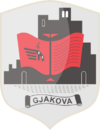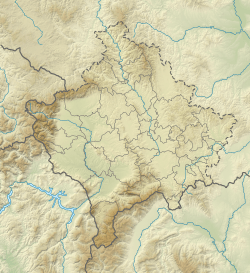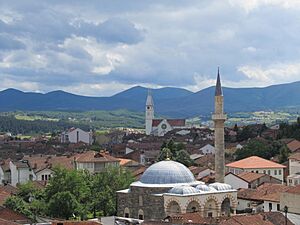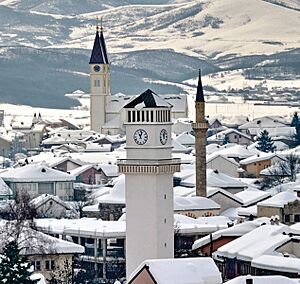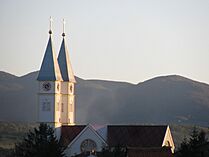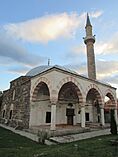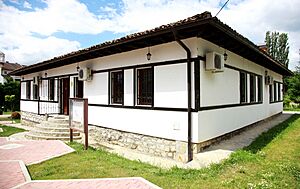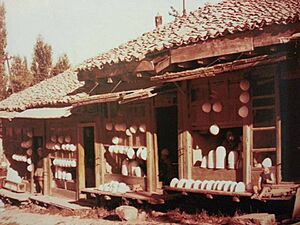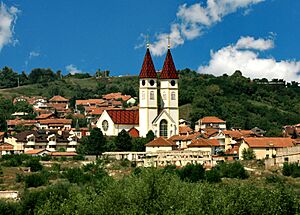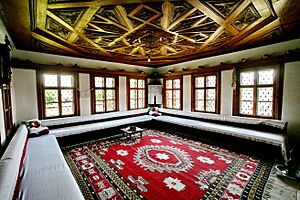Gjakova facts for kids
Quick facts for kids
Gjakova
|
|||
|---|---|---|---|
|
City and municipality
|
|||
|
The city at night
Old Bazaar
Saint Paul and Saint Peter's Church
|
|||
|
|||
| Country | Kosovo | ||
| District | Gjakova | ||
| Municipality | Gjakova | ||
| Area | |||
| • Municipality | 586.91 km2 (226.61 sq mi) | ||
| Area rank | 4th in Kosovo | ||
| Elevation | 375 m (1,230 ft) | ||
| Population
(2024)
|
|||
| • Municipality | 78,824 | ||
| • Rank | 6th in Kosovo | ||
| • Density | 134.3034/km2 (347.844/sq mi) | ||
| Demonym(s) | Albanian: Gjakovar (m), Gjakovare (f) | ||
| Time zone | UTC+1 (CET) | ||
| • Summer (DST) | UTC+2 (CEST) | ||
| Postal code |
50000
|
||
| Area code(s) | +381 390 | ||
| Vehicle registration | 07 | ||
Gjakova (also known as Đakovica) is a city in Kosovo. It is the sixth largest city in Kosovo. In 2024, about 78,824 people lived in the Gjakova area.
The city is in the southwest of Kosovo. It is located between the cities of Peja and Prizren. Gjakova is about 100 kilometers (62 miles) from the Adriatic Sea. It is also about 80 kilometers (50 miles) west of Pristina, the capital of Kosovo.
People have lived in Gjakova since ancient times. During the time of the Ottoman Empire, Gjakova was an important trading center. It was on the trade route between Shkodra and Constantinople. It became one of the busiest trade centers in the Balkans region.
Contents
What's in a Name?
The Albanian name for the city is Gjakova. There are a few ideas about where the name came from. One idea is that it comes from the name Jakov. This was a nobleman who helped found the city. Another idea is that it comes from the Serbian word đak, meaning "pupil". A third idea is that it comes from the Albanian word gjak, which means "blood".
A Look at Gjakova's Past
Early History
Gjakova was first mentioned as a village with a market in 1485. It had 54 households back then. Local Albanians helped it grow into a town in the 1500s. It became a settlement mostly with Albanian people. It grew around buildings made by Hadim Suleyman Efendi, an important local Albanian.
In the 1600s, writers like Katip Çelebi and Evliya Çelebi described Gjakova. They said it had 2,000 houses and 300 shops. Gjakova became a busy Ottoman trade center. Its marketplace was near the Hadum Mosque, which was built in 1594. Evliya Çelebi called it a "flourishing and attractive town" in 1662.
Modern Times
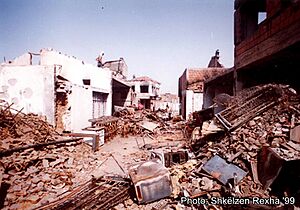
Gjakova faced many challenges during the First Balkan War. Later, during World War II, Kosovo became part of Greater Albania.
In the 1950s, there were efforts to make Albanians leave the region. People in Gjakova protested this. They even showed the banned Albanian flag in 1956. This led to more protests by students.
The city was badly damaged during the Kosovo War in 1999. Many buildings were destroyed. Many people also suffered. After the war, most of the Albanian people returned. Much of the town was rebuilt.
Where is Gjakova?
Gjakova is in the southwest part of Kosovo. To the northeast, you can see the plain of Metohija. To the southwest, the Accursed Mountains rise up. The city is also at the start of the Erenik Valley. The Krena River flows through this valley. It then joins the White Drin, which is the longest river in Kosovo.
What is Gjakova's Weather Like?
Gjakova has a Humid subtropical climate. This means it has warm, humid summers and mild winters. The average yearly temperature is about 11.5°C (52.7°F). August is the warmest month, with an average of 22.5°C (72.5°F). January is the coldest, with an average of 0.7°C (33.3°F).
Who Lives in Gjakova?
| Municipal historical population | ||
|---|---|---|
| Year | Pop. | ±% |
| 1948 | 39,998 | — |
| 1953 | 44,415 | +11.0% |
| 1961 | 53,270 | +19.9% |
| 1971 | 71,374 | +34.0% |
| 1981 | 92,303 | +29.3% |
| 1991 | 115,097 | +24.7% |
| 2011 | 94,556 | −17.8% |
| 2024 | 78,824 | −16.6% |
| Source: [1] [2] | ||
In 2024, the total population of Gjakova was 78,824 people. Slightly more than half of the population are females.
Most people in Gjakova are Albanians. There are also smaller groups like Balkan Egyptians, Roma, and Ashkali.
Most people in Gjakova are Muslim. A smaller number of people are Roman Catholic Christians. Christianity has been in Gjakova since the time of the Roman Empire. Islam spread early during the Ottoman Rule.
How Gjakova Makes Money
Gjakova's economy used to be based on farming and small workshops. After World War II, it grew to include industry and services. Today, Gjakova's economy relies on private businesses.
By 2012, there were over 4,120 registered businesses in Gjakova. These businesses work in many areas. They include manufacturing, construction, services, trade, and more. Gjakova currently has about 12,000 people working. Most of them work in the private sector.
The economy of Gjakova faced challenges during the war. Many businesses were damaged or destroyed. However, the city has been rebuilding.
Some important industries in Gjakova are:
- Metal industry: They make things like metal ropes, nails, and pipes.
- Textile industry: They produce cotton fabrics, artificial leather, and clothes.
- Chemical industry: They make shampoos and other cleaning products.
- Food industry: They produce flour, bread, eggs, pasta, chocolate, and wines.
- Construction industry: They make bricks, blocks, tiles, and wooden houses.
Most businesses in Gjakova are small family-owned shops. These include retail stores, cafes, and basic service providers.
Learning in Gjakova
Gjakova has a long history of education. There was a famous library called the Hadim Aga library. People said it was very rich in books.
Schools teaching in Albanian were open in Gjakova before 1840. Important Albanian thinkers helped open these schools. Religious schools, like madrasas, also played a big role in education.
Today, Gjakova has many primary and secondary schools. There are public and private schools. The city also has a university. The University of Gjakova Fehmi Agani opened in 2013. It is one of Kosovo's newest public universities.
Gjakova's Culture
Gjakova has many historical buildings. These include cultural, religious, and social sites. The city center grew around the Old Bazaar. This was a hub for trade and crafts. By 1900, the bazaar had about 1,000 businesses. Many bridges were built for trade caravans. Inns were also built to host visitors.
The Old or Grand Bazaar (Çarshia e Madhe) is the oldest bazaar in Kosovo. It was the main trading center and heart of the city. It was damaged during the Kosovo War but has been rebuilt. The Hadum Mosque, built in the 1500s, is next to the bazaar. The bazaar is still active today. It has about 500 shops along its 1-kilometer (0.6-mile) main road.
The Hadum Mosque was built in 1594 by Mimar Sinan. It was paid for by Hadum Aga. This mosque has been very important to the city's look and feel for centuries. Its building led to many craft shops opening around it. This made the city even more important.
Gjakova also has two main Catholic Churches. The Saint Paul and Saint Peter Church is one of the tallest buildings in Gjakova. It can be seen from many parts of the city. The original church was destroyed in 1999 during the war. A new cathedral has been built in the same spot.
The Saint Ndou Church was built in 1931. It has been renovated several times.
The Clock Tower was built after the Hadum Mosque. It showed how fast Gjakova's economy was growing. It was destroyed during the Balkan Wars. A new clock tower was built later. It is about 30 meters (98 feet) tall. It is made of stone with a wooden top.
Fun Festivals
Gjakova hosts many festivals and cultural events. These often take place in the Old Town. Some events are seasonal, while others happen every year. They attract both locals and visitors. Some events are organized by the city, and some by private groups.
Sports in Gjakova
Gjakova is also known for its sports. It has 38 sports clubs that compete in various leagues across Kosovo. The most successful team is KF Vëllaznimi. This football club has won 9 titles in the Kosovar Superliga. They have also won 4 Kosovo Cups.
The city's sports hall is called "Shani Nushi." It can hold 3,500 people. The Gjakova City Stadium can hold 6,000 people.
Getting Around
Gjakova has old railway lines that are not used anymore. The closest airport is Pristina International Airport. It is about 70 kilometers (43 miles) east of Gjakova. This is the only airport for travelers coming to Kosovo by air.
There is also the Gjakova Airport north of the city. It is expected to become a public airport soon. It will be used by low-cost commercial airlines and cargo flights.
Gjakova's International Friends
Gjakova is twinned with these cities:
 Fort Dodge, United States
Fort Dodge, United States Jamestown, United States
Jamestown, United States Lodève, France
Lodève, France Saranda, Albania
Saranda, Albania
Famous People from Gjakova
Many notable people come from Gjakova. Here are a few:
- Gjon Nikolle Kazazi – An Albanian Catholic bishop.
- Fehmi Agani – An Albanian sociologist and politician.
- Fadil Hoxha – The first Prime Minister of Kosovo.
- Bekim Fehmiu – A famous Yugoslav-Albanian actor.
- Ali Podrimja – A well-known Albanian poet.
- Muslim Mulliqi – An Albanian painter.
- Naim Kryeziu – An Albanian footballer.
- Lorik Cana – A famous Albanian footballer and team captain.
- Nora Gjakova – An Olympic judo champion.
- Atifete Jahjaga – A former President of Kosovo.
Images for kids
See also
 In Spanish: Đakovica para niños
In Spanish: Đakovica para niños






